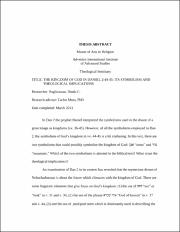The kingdom of God in Daniel 2:44-45 : its symbolism and theological implications
Abstract
In Dan 2 the prophet Daniel interpreted the symbolisms used in the dream of a great image as kingdoms (vv. 36-45). However, of all the symbolisms employed in Dan 2, the symbolism of God’s kingdom in vv. 44-45 is a bit confusing. In this text, there are two symbolisms that could possibly symbolize the kingdom of God: אבן “stone” and טור
“mountain.” Which of the two symbolisms is attested in the biblical text? What is/are the theological implication/s?
An examination of Dan 2 in its context has revealed that the mysterious dream of Nebuchadnezzar is about the future which climaxes with the kingdom of God. There are some linguistic elements that give focus on God’s kingdom: (1) the use of חזה “see” or “look” in v. 31 and v. 34, (2) the use of the phrase אלה שׁמיא “God of heaven” in v. 37 and v. 44, (3) and the use of peal/pael stem which is dominantly used in describing the
world kingdoms (vv. 36-43) but changes to haphel/aphel stem in describing God’s kingdom (vv. 44-45). These linguistic elements draw attention to the theme and emphasize the difference between the world kingdoms and God’s kingdom. The previous is short-lived and destructible, while the latter is enduring and indestructible.
In the interpretation section (vv. 36-45), the use of the preposition כ “as” or “like” in vv. 44-45 accentuates that the kingdom of God is analogous to the stone only in the aspect of the breaking activity, not the idea that the stone is the kingdom of God. Moreover, the symbolisms written with a definite article א “the” which are consistently interpreted as kingdoms in vv. 36-43 suggests that it is consistent to associate the kingdom of God to the mountain symbolism which is written in a definite form, than with the stone symbolism which is written in an indefinite form. Furthermore, the morphological and semantic studies of the stone and mountain symbolisms in Biblical Hebrew, Biblical Aramaic, and Ancient Near East have shown that the mountain symbolism gains more depiction of God than the stone.
Based on the evidences, it is deduced that the kingdom of God in Dan 2:44-45 is symbolized by the mountain where the stone was cut out. This interpretation is theologically significant for it emphasizes that God’s kingdom is pre-existent and concurrent with the world kingdoms, yet it will be established in the eschatological period. Hence the concept of God’s kingdom with the use of mountain symbolism also emphasizes of a future eternal kingdom of God established in the new earth. It must be noted, however, that the stone is not treated insignificant, for in this respect, the stone symbolism describes how God’s kingdom will be established at a divinely appointed event in time through the second coming of Jesus.
Knowing that the establishment of God’s kingdom will consummate the history of the world kingdoms (vv. 44-45; cf. 7:27), it drives a concept of the end of evil and oppression. In God’s kingdom, the people of God or the saints will live free from the intrusion of the enemies, they will live with God forever and ever, and they will share in God’s dominion over His kingdom. Thus the concept of God’s kingdom is significant in the Old Testament hope.


